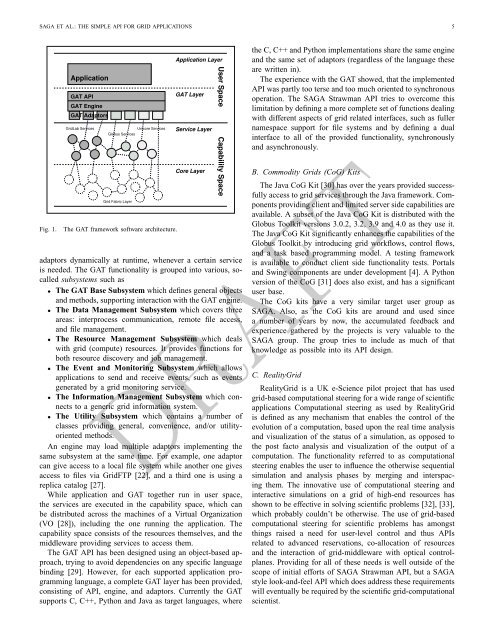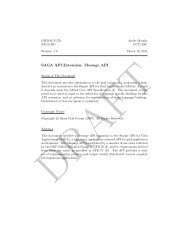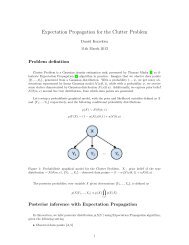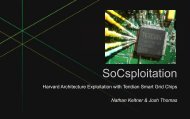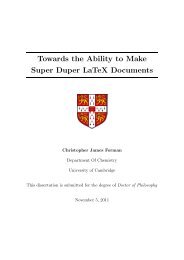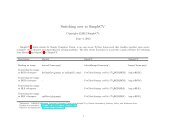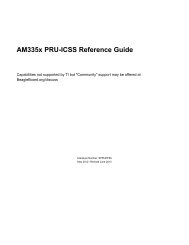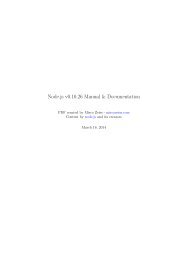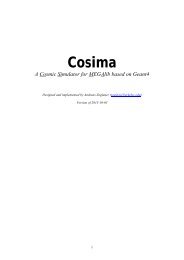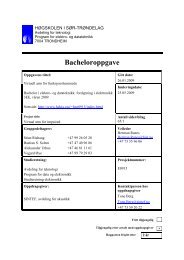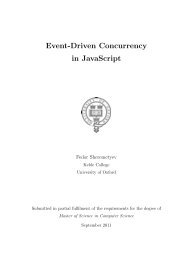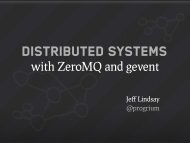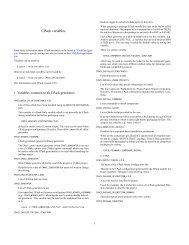4 COMPUTATIONAL METHODS IN SCIENCE AND TECHNOLOGYB. <strong>Grid</strong>RPC-WGThe <strong>Grid</strong>RPC <strong>API</strong> [13] represents ongoing work to standardizeand implement a portable and simple remote procedurecall (RPC) mechanism <strong>for</strong> grid computing. This standardizationef<strong>for</strong>t is being pursued through <strong>Grid</strong>RPC WorkingGroup at GGF. The initial work in that group showed thatclient access to existing grid computing systems such asNetSolve [14], Ninf [15], and DIET [16], can be unified via acommon <strong>API</strong>, a task that has proven to be problematic in thepast. The group successfully created such an <strong>API</strong> specification,which is now a GGF Draft Recommendation [17].The cooperation with the <strong>SAGA</strong>-WG allows the <strong>Grid</strong>RPC-WG to broaden the target user community <strong>for</strong> <strong>Grid</strong>RPCsignificantly, and would also equip the <strong>Grid</strong>RPC <strong>API</strong> witha look & feel which is compatible with the one used <strong>for</strong> othergrid programming paradigms. For example, the model <strong>for</strong>asynchronous calls used <strong>for</strong> RPCs will match the model <strong>for</strong>asynchronous calls of other paradigms, e.g. remote file access.C. <strong>Grid</strong>CPR-WGGGFs <strong>Grid</strong> Checkpoint and Recovery (<strong>Grid</strong>CPR) WorkingGroup [18] is devising an architecture <strong>for</strong> checkpointing longrunning applications <strong>for</strong> later recovery, possibly on differentgrid resources. <strong>Grid</strong>CPR use cases include fault resilience,intermittent operation (using small time slices until final completion),as well as parameter space exploration using various,related checkpoints.The currently envisioned architecture encompasses services<strong>for</strong> authentication/authorization, job management, checkpointstate management, checkpoint transfer, and event handling.<strong><strong>Application</strong>s</strong> are supposed to use a <strong>Grid</strong>CPR library, providingan <strong>API</strong> to these services. Details of this <strong>API</strong> arecurrently under investigation. As several concepts are similarto those defined by the <strong>SAGA</strong> <strong>API</strong> (copy/move checkpointfiles, read/write data, find files etc.), compatibility with <strong>SAGA</strong>is desired. That would provide application programmers witha more complete and consistent interface to the grid relatedcapabilities offered by the <strong>API</strong>s.D. OGSA-WGThe Open <strong>Grid</strong> Services Architecture (OGSA) WorkingGroup at GGF defines a Web Service based architecture whicheventually will be the overarching design principle <strong>for</strong> all gridservices. The problem space targeted by the OGSA group atfirst seems unrelated to the <strong>SAGA</strong> ef<strong>for</strong>t but, in fact, representsthe class of service-oriented, middleware architectures thatcould be the target plat<strong>for</strong>m <strong>for</strong> many <strong>SAGA</strong> implementations.Such service-oriented architectures address many issues, suchas resource naming, state management, and security, that willrequire a simplified mapping into the <strong>SAGA</strong> <strong>API</strong>. Hence, the<strong>SAGA</strong>-WG is in active communication with the OGSA groupand other OGSA-related ef<strong>for</strong>ts to ensure the proper levelof compatibility by cross-reviewing their respective standarddocuments and by providing <strong>SAGA</strong> reference implementationson OGSA-based middleware systems.E. Other GGF Working GroupsThe <strong>Grid</strong> File Systems (GFS) Working Group [19] targetsthe definition of a architecture which integrates physical filesystems into a single global, uni<strong>for</strong>m name space [20]. The<strong>SAGA</strong>-WG uses the definitions <strong>for</strong> name spaces defined bythe GFS-WG, and hence has the same notion of files anddirectories as that group.The Byte-IO Working Group [21] defines an OGSA compatibleservice which allows <strong>for</strong> efficient remote access tobinary data, e.g. files. Also, the <strong>Grid</strong>FTP Working Group [22]defined extensions to the standard FTP protocol which allows<strong>for</strong> efficient memory-to-memory and disk-to-disk data transferin grids. Both groups invest significant time in exploringparadigms <strong>for</strong> efficient remote data access. These paradigmsare partially reflected by the <strong>SAGA</strong> <strong>API</strong>.The JSDL Working Group [23] defines a XML based JobSubmission and Description Language. Although the <strong>SAGA</strong><strong>API</strong> currently refrains from any explicit usage of XML, thekeywords used <strong>for</strong> the <strong>SAGA</strong> job descriptions reflect thosedefined by JSDL.The Persistent Archive (PA) Research Group [24], DataReplication (REP) Research Group [8] and the OGSA ReplicaServices (OREP) Working Group [25] have all worked onthe services that manage distributed data files <strong>for</strong> data grids.Their work [26] is reflected in the <strong>SAGA</strong> Logical File <strong>API</strong>,which adopts the concept of logical files (or ’replicas’) thatwas defined by these groups.IV. RELATED WORKThe work on the <strong>SAGA</strong> <strong>API</strong> is not an isolated ef<strong>for</strong>t, butbuilds on top of a number of previous projects targeting thesame problem space. The Globus-CoG is probably the mostprominent representative of an <strong>API</strong> which tries to specificallyabstract the Globus package. The GAT from the EU-<strong>Grid</strong>Labproject targets already a more general abstraction of gridparadigms, and follows similar design principles as <strong>SAGA</strong>.Other projects such as Reality<strong>Grid</strong> and Data<strong>Grid</strong>/EGEE/LHCtarget the same problem space, but with interfaces withstronger focus on specific community needs. This sectiondescribes these ef<strong>for</strong>ts and their influence on <strong>SAGA</strong> in somedetail. In general, the <strong>SAGA</strong>-WG can be seen as the “GrandUnification” of all these grid <strong>API</strong>s, which provides a moreuni<strong>for</strong>m, middleware independent and standardized solution<strong>for</strong> grid application programmers.DRAFTA. GATThe design of the Strawman <strong>API</strong> and the ongoing workon a <strong>SAGA</strong> engine implementing this Strawman <strong>API</strong> is verymuch influenced by the experiences collected with the <strong>Grid</strong><strong>Application</strong> Toolkit (GAT [3]).Figure 1 shows the GAT architecture. It mainly distinguishesbetween user space and capability space. In user space runsthe application code that has been programmed using the GAT<strong>API</strong>. The GAT engine is a lightweight layer that dispatchesGAT <strong>API</strong> calls to service invocations via GAT adaptors.Adaptors are specific to given services and hide all servicespecificdetails from the GAT. A GAT engine typically loads
<strong>SAGA</strong> ET AL.: THE SIMPLE <strong>API</strong> FOR GRID APPLICATIONS 5Fig. 1.<strong>Application</strong>GAT <strong>API</strong>GAT EngineGAT Adaptors<strong>Grid</strong>Lab ServicesUnicore ServicesGlobus Services<strong>Grid</strong> Fabric LayerThe GAT framework software architecture.<strong>Application</strong> LayerGAT LayerService LayerCore Layeradaptors dynamically at runtime, whenever a certain serviceis needed. The GAT functionality is grouped into various, socalledsubsystems such as• The GAT Base Subsystem which defines general objectsand methods, supporting interaction with the GAT engine.• The Data Management Subsystem which covers threeareas: interprocess communication, remote file access,and file management.• The Resource Management Subsystem which dealswith grid (compute) resources. It provides functions <strong>for</strong>both resource discovery and job management.• The Event and Monitoring Subsystem which allowsapplications to send and receive events, such as eventsgenerated by a grid monitoring service.• The In<strong>for</strong>mation Management Subsystem which connectsto a generic grid in<strong>for</strong>mation system.• The Utility Subsystem which contains a number ofclasses providing general, convenience, and/or utilityorientedmethods.An engine may load multiple adaptors implementing thesame subsystem at the same time. For example, one adaptorcan give access to a local file system while another one givesaccess to files via <strong>Grid</strong>FTP [22], and a third one is using areplica catalog [27].While application and GAT together run in user space,the services are executed in the capability space, which canbe distributed across the machines of a Virtual Organization(VO [28]), including the one running the application. Thecapability space consists of the resources themselves, and themiddleware providing services to access them.The GAT <strong>API</strong> has been designed using an object-based approach,trying to avoid dependencies on any specific languagebinding [29]. However, <strong>for</strong> each supported application programminglanguage, a complete GAT layer has been provided,consisting of <strong>API</strong>, engine, and adaptors. Currently the GATsupports C, C++, Python and Java as target languages, whereUser Space Capability Spacethe C, C++ and Python implementations share the same engineand the same set of adaptors (regardless of the language theseare written in).The experience with the GAT showed, that the implemented<strong>API</strong> was partly too terse and too much oriented to synchronousoperation. The <strong>SAGA</strong> Strawman <strong>API</strong> tries to overcome thislimitation by defining a more complete set of functions dealingwith different aspects of grid related interfaces, such as fullernamespace support <strong>for</strong> file systems and by defining a dualinterface to all of the provided functionality, synchronouslyand asynchronously.B. Commodity <strong>Grid</strong>s (CoG) KitsThe Java CoG Kit [30] has over the years provided successfullyaccess to grid services through the Java framework. Componentsproviding client and limited server side capabilities areavailable. A subset of the Java CoG Kit is distributed with theGlobus Toolkit versions 3.0.2, 3.2, 3.9 and 4.0 as they use it.The Java CoG Kit significantly enhances the capabilities of theGlobus Toolkit by introducing grid workflows, control flows,and a task based programming model. A testing frameworkis available to conduct client side functionality tests. Portalsand Swing components are under development [4]. A Pythonversion of the CoG [31] does also exist, and has a significantuser base.The CoG kits have a very similar target user group as<strong>SAGA</strong>. Also, as the CoG kits are around and used sincea number of years by now, the accumulated feedback andexperience gathered by the projects is very valuable to the<strong>SAGA</strong> group. The group tries to include as much of thatknowledge as possible into its <strong>API</strong> design.C. Reality<strong>Grid</strong>Reality<strong>Grid</strong> is a UK e-Science pilot project that has usedgrid-based computational steering <strong>for</strong> a wide range of scientificapplications Computational steering as used by Reality<strong>Grid</strong>is defined as any mechanism that enables the control of theevolution of a computation, based upon the real time analysisand visualization of the status of a simulation, as opposed tothe post facto analysis and visualization of the output of acomputation. The functionality referred to as computationalsteering enables the user to influence the otherwise sequentialsimulation and analysis phases by merging and interspacingthem. The innovative use of computational steering andinteractive simulations on a grid of high-end resources hasshown to be effective in solving scientific problems [32], [33],which probably couldn’t be otherwise. The use of grid-basedcomputational steering <strong>for</strong> scientific problems has amongstthings raised a need <strong>for</strong> user-level control and thus <strong>API</strong>srelated to advanced reservations, co-allocation of resourcesand the interaction of grid-middleware with optical controlplanes.Providing <strong>for</strong> all of these needs is well outside of thescope of initial ef<strong>for</strong>ts of <strong>SAGA</strong> Strawman <strong>API</strong>, but a <strong>SAGA</strong>style look-and-feel <strong>API</strong> which does address these requirementswill eventually be required by the scientific grid-computationalscientist.DRAFT


